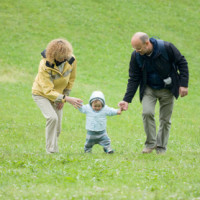Written by Vicki Anderson, Speech-Language Pathologist, Mecklenburg County CDSA
Coming up with practical, functional outcomes with families is a continual balancing act of meeting the family where they are and writing outcomes that lead to multiple opportunities for learning. When the family comes to us with concerns about their child’s speech development, it is often especially challenging to find functional outcomes within their day. We are all aware of how many times families voice concerns such as, “I want my child to tell me when he needs to go to the potty,” “I want him to talk all the time,” and “I want her to tell me when she is hungry.” Unfortunately, these tend to be either too broad or very limiting when it comes time for the family and provider to address these outcomes. In early intervention, we want to be writing outcomes that are achievable and measurable, in the sense that everyone who is a part of the IFSP team can get a good picture of what we want a successful result to look like. We want outcomes that allow us to help the child participate more successfully within the family’s daily routines.
Part of the issue could be in setting up our conversations with families by asking what times of the day are difficult or what problems they want to solve. We need to include in our discussions such questions as, “What things would you like your child to be able to tell you about?” “What kind of conversations would you like to be able to have?” “Is there a time of day that is fun and stress-free for your family when it would be easier to focus on your child’s language skills?” Language is a part of so much that we do throughout our day. We could also ask parents to talk about specific routines, such as, “Tell me what your child does on trips to the store,” “What does it look like when you look at books with your child?” “What does your child do while playing outside/going to the park/taking a walk?” If we can help families see the opportunity for language in all aspects of their day, we may see richer outcomes that can yield more focused visits with families and more consistent daily use of the activities.
For example, if the family takes a walk to the park most days, explore what they do on the way there and what could make it a richer experience for the child. Perhaps an outcome that looks at the child’s interests and ways to engage the child would open up more conversation about how to include aspects of all areas of development – motor, social, cognitive, and language. So many language opportunities abound with things to see, smell, hear, and do, and all are open for natural language modeling and conversation.
Likewise, a family meal is usually about so much more than just asking for food or drink. If it is a family who eats together and talks together, consider how much more the child in our program could participate in the meal time activity. Can the child talk about what he is eating and drinking? Not just what the food names are, but comments like whether he likes it, whether it is hot or cold, sweet or sour, red or green. Can he share in comments about how he spent his day? Do the parents have a way of getting information from the child’s sitter or daycare provider to help prompt the conversation about his day?
Perhaps playtime with siblings is difficult, but it is also an opportunity for learning. Can older siblings participate in the plan by modeling language and teaching the child new ways to play while their mother is trying to get some cleaning done? Many siblings are excited to be considered a “teacher” for their younger brother or sister and can do some wonderful language modeling with a little coaching and encouragement. Often, young children are more likely to imitate a sibling or another child than they are a parent or other adult. Playtime can also be rich with opportunities to help expand what the child understands and teach older siblings how to adjust their interactions for this child’s receptive and expressive abilities.
Let’s help our families see how much richer the good times of the day could be with more participation from their child. Let’s step outside the box of “problems” and “difficult times of day” to “opportunities for growth” and “making good times even better.” With a little time and exploration of the family’s routines and interests, maybe we will see fewer outcomes that are too general or too limiting, and instead see more variety and creativity as we look further into routines that are important to each family.






No comments yet.